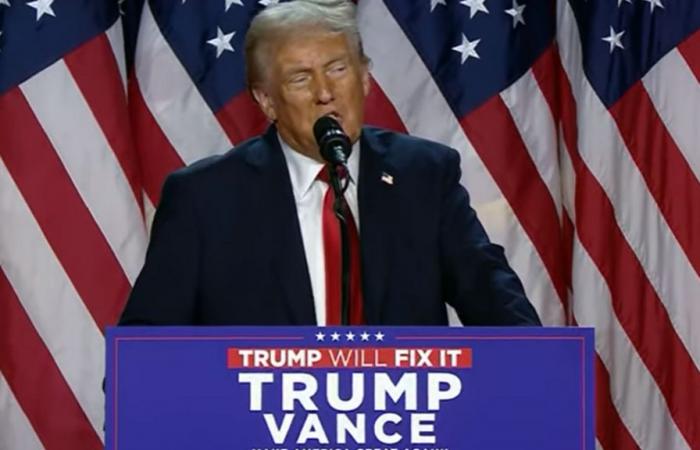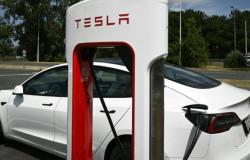In terms of protectionism, the potion promises to be much more bitter than during Donald Trump's first term. Although the Republican candidate's statements varied during the campaign, he promised to implement 10% customs duties on all products imported by the United States. Donald Trump's favorite target, China would see customs tariffs of 60% applied to all its exports to the United States, compared to 25% currently on some of them.
The movement goes much further than the protectionist measures adopted during the first Trump term, which covered $300 billion in Chinese products and were maintained by Joe Biden. “This would correspond to between 5 and 7 times the amounts involved in the first trade war between the United States and China”underlines Marcos Carias, North America economist for the credit insurer Coface. Its entire implementation will depend largely on Republican control of the House of Representatives, while their victory in the Senate has already been achieved.
This new trade war could cause a global explosion. For European and French exporters, first of all, who sell around 8% of their exports to the United States and who risk losing competitiveness. Nothing ensures that old commercial conflicts, frozen but not resolved in substance, like the one around Airbus will not resurface. Especially since the next tenant of the White House has never hidden his distrust of his European partners.
Towards a massive reduction in taxation
Many of the larger companies are already producing locally for the US market and have already made plans to reorganize their supply chain. “In 2017 and 2018, the customs duties were put in place several months after their announcement, which gave American importers time to adapt. There is a feeling this time that it could go faster», underlines Emily S. Stausbøll, analyst for the Xeneta firm specializing in maritime freight. For several weeks, some importers have started to replenish their stocks in anticipation. “This could become even more significant after the Republican victory.pointed out the analyst, before the result was known. Adaptation is likely to be more complicated for smaller exporters. Still, Donald Trump's desire to thoroughly renegotiate the free trade agreement with Canada and Mexico, which is subject to a review clause in 2026, could further complicate supply chains. Indeed, Mexico appears to be a production base close to the American market.
Beyond, “Customs duties of 60% risk further slowing down Chinese growth. However, many countries, African for example, depend on the good health of the Chinese economy.points out Julien Marcilly, economist for Global Sovereign advisory who expects a cold snap in global growth. In the United States, protectionism should result in a surge in inflation.
For Republicans, these tariff increases should bring in $270 billion, or 1% of American GDP. Donald Trump intends to use these revenues to finance all-out tax cuts, for households and businesses. The next American president plans to perpetuate the massive tax cuts adopted during his first term, and which will have to be renegotiated by Congress in 2025. Among his campaign promises, the Republican also called for the tax exemption of overtime income and social benefits. The other new tax boost concerns corporate tax. During his first term, the next American president had already lowered it from 35% to 21%. Donald Trump promised to bring it back to 15% this time. On health policy, “Donald Trump has remained relatively vague, but is moving in the more general direction of less state intervention”notes Coface again.
Unfailing support for hydrocarbons, to the detriment of the climate
After Donald Trump’s victory, the future ofInflation reduction act (IRA) the major program to develop the production of green technologies put in place by Joe Biden, and which so worried European manufacturers, remains uncertain. The American president had promised in April to cancel the remaining funds to be committed to the envelope of 380 billion dollars over ten years implemented by the Democrats. In particular, he mentioned in August a possible elimination of the $7,500 tax credits for the purchase of electric vehicles, despite the commitment of Elon Musk at his side.
The fact remains that the massive tax credits granted to manufacturers to open solar panel or electric battery factories on American soil have mainly benefited Republican states, which voted for them on November 5. In Congress, a group of Republican elected officials already published a letter this summer calling for maintaining the IRA. “Donald Trump could stop subsidies for decarbonization processes, energy renovation… For example, clean energy demonstrators cost millions: it's too big for venture capital, too risky for infrastructure funds. There are $28 billion in federal funds dedicated to this subject. anticipates in an interview with L'Usine Nouvelle Elisabeth Reynolds, an economist at MIT who had been special advisor to Joe Biden for industry from 2021 to 2022.
Unfailing support for the oil sector
In his victory announcement speech, Wednesday, November 6 in the morning (French time), Donald Trump underlined his unvarnished support for oil and gas. “We have more liquid gold – oil and gas – than any country in the world, more than Saudi Arabia. We have more than Russia”. The United States has become the world's leading producer of hydrocarbons, with 20.2 million barrels of petroleum products per day – including 12.9 mb/d of crude oil – and 3.5 billion cubic meters per day of gas in 2023. This inexpensive energy windfall primarily irrigates the country's domestic consumption and industry, but has also enabled the federal state to become the largest exporter of liquefied natural gas in 2023.Shale oil and gas production exploded under the Trump mandate, after a start under Obama. recalled Anne-Sophie Corbeau, gas expert at the Center on Global Energy Policy at Columbia University, a few days before the election.
Unsurprisingly, a new Trump presidency – who has already promised to exit the Paris Agreement on global warming again and repeatedly repeats the mantra “drill, baby, drill” – would be favorable to the oil and gas sector. The Republican plans to encourage the construction of new oil infrastructure and thermal power plants with few environmental guarantees, particularly on methane emissions. Donald Trump also assured that he would return, from the first day of his mandate, to the moratorium imposed by Joe Biden on the installation of new gas liquefaction capacities. However, investment decisions will mainly depend on the long-term contracts signed. Not to mention that a return of Russia to the gas market, in the event of an end to the war in Ukraine, would change the situation.
Despite many uncertainties about the measures actually implemented, rolling back the IRA and other environmental standards adopted by the Biden administration alone could add 4 billion tons of CO2 to the atmosphere by 2030 according to a compilation of models carried out by the specialist media Carbon Brief at the start of the year. Or the combined emissions of the European Union and Japan.






